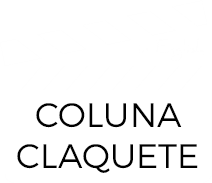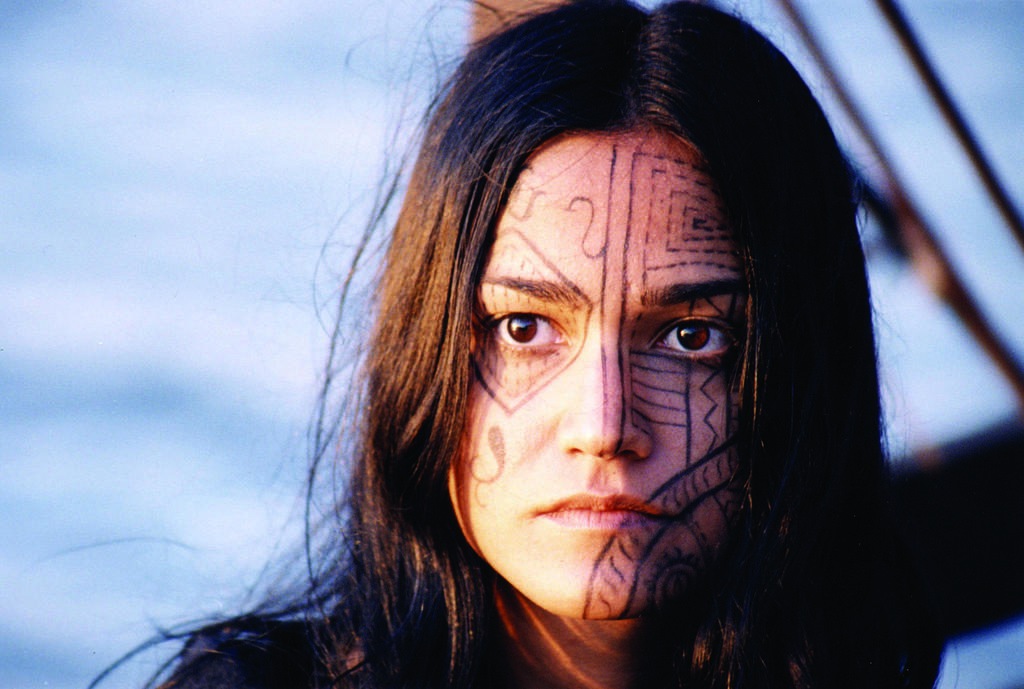Recommended movie: “Brave New Land”
Knights of Troy from Pantanal
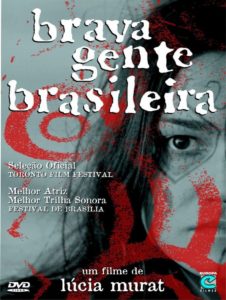 For a long time I had some prejudice regarding brazilian cinema. Perhaps because my youth coincided with the “pornochanchadas” age, I took a certain dislike of brazilian productions, giving preference to what came from abroad. As I matured, I learned that nothing is perfect (not even me), and that it is better to experiment first, and then criticize.
For a long time I had some prejudice regarding brazilian cinema. Perhaps because my youth coincided with the “pornochanchadas” age, I took a certain dislike of brazilian productions, giving preference to what came from abroad. As I matured, I learned that nothing is perfect (not even me), and that it is better to experiment first, and then criticize.
There is nothing worse than a “I did not see and do not like” opinion. There are great Brazilian productions, just like Hollywood products that are not worth what Garfield buries – or would, if he had the courage. An interesting experience was to watch “Brave New Land” (“Brava Gente Brasileira”, BRA, 2000), directed by Lúcia Murat.
I confess to you that I chose the movie wrong. From the similarity of the title, I thought it was based on the novel by João Ubaldo Ribeiro, “An invincible memory” (“Viva o povo brasileiro”). Once the mistake was solved, I discovered that the plot of the film is based on a historical fact, which occurred in Mato Grosso do Sul, bordering Paraguay, at the end of the 18th century.
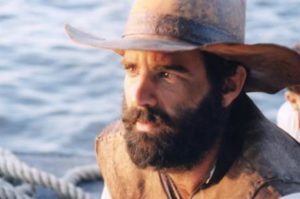 In 1778, the Portuguese cartographer Diogo de Castro and Albuquerque (Diogo Infante) was hired by Portuguese government to do the topographic survey of Forte Coimbra area, located on the right bank of the middle Paraguay River. In addition to problems with the Spaniards, who dominated the rest of South America, the region was inhabited by the Paiaguás and Guaicurus Indians. The latter group had a remarkable development, even developing the ability to tame and use horses in war incursions. They were known as the Indian horsemen.
In 1778, the Portuguese cartographer Diogo de Castro and Albuquerque (Diogo Infante) was hired by Portuguese government to do the topographic survey of Forte Coimbra area, located on the right bank of the middle Paraguay River. In addition to problems with the Spaniards, who dominated the rest of South America, the region was inhabited by the Paiaguás and Guaicurus Indians. The latter group had a remarkable development, even developing the ability to tame and use horses in war incursions. They were known as the Indian horsemen.
The expedition that drove Diogo was commanded by Captain Pedro, an impetuous and violent soldier, who led friends and enemies with the same truculence. On the way to Fort Coimbra, they found some Indian women bathing in a river. In a practice that must have been common for centuries, soldiers captured and raped the Indies, killing them at the end.
Separating one of them, Pedro handed it over to Diogo, to prove to men that he was not a “sodomite,” a pejorative term for homosexual. Disturbed by the fever and the privations of the strenuous journey, Diogo gave in to impulses and violated the young woman. Then, tormented by remorse, he prevented Pedro from executing her, taking her along with the expedition. The other survivor was a white boy, who would have been kidnapped by the Indians.
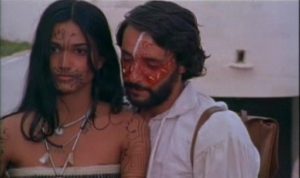 The days that followed, already in the fort, brought to Diogo a new vision of life. Far from civilization and the strict moral and religious standards of the Court, Diogo started a loving relationship with the Indian Ánote, with mutual discoveries that surprised, delighted and frightened the young Portuguese. The remembrance of his Portuguese bride, noble, rich and virgin, got more and more distant.
The days that followed, already in the fort, brought to Diogo a new vision of life. Far from civilization and the strict moral and religious standards of the Court, Diogo started a loving relationship with the Indian Ánote, with mutual discoveries that surprised, delighted and frightened the young Portuguese. The remembrance of his Portuguese bride, noble, rich and virgin, got more and more distant.
While the Indian horsemen mourned their dead relatives, Diogo and the fort commander had their own problems, facing discrimination from the Church, which condemned any relationship with indigenous women. Diogo was happy to discover that Ánote was pregnant, dreaming of a person with the best qualities of the two civilizations.
Unfortunately for Diogo, the ancestral customs and hates spoke louder, and, the son so dreamed did not come. Soon after, the Indians used a skillful trick to invade the fort, decimating fifty-four occupants. It would still be twelve long years before a peace agreement was reached between the Indians and the Portuguese.
 The Trojan-style massacre was the actual fact on which the script was based. Most of the filming was done in real Forte Coimbra, a place that is still difficult to reach, where the only communication with the world is a solitary telephone booth. The final result of the movie reflects the difficulties of production, both logistic and financial. However, even occasional flaws in the script do not detract from the brightness of this interesting production.
The Trojan-style massacre was the actual fact on which the script was based. Most of the filming was done in real Forte Coimbra, a place that is still difficult to reach, where the only communication with the world is a solitary telephone booth. The final result of the movie reflects the difficulties of production, both logistic and financial. However, even occasional flaws in the script do not detract from the brightness of this interesting production.
Of all the Indian characters, only Luciana Rigueira, who played Ánote character, was a professional actress. All others were Kadiwéus, subgroup of the original Guaicurus. None of them had the least notion of scenic art, but they managed to interpret themselves magnificently.
The Kadiwéus, who at first would be only source of consultation, grounded in a decisive way the film, be it in the habits, consuetudes and uses, but also influenced in the way the scenes were realized. The director herself acknowledges that she felt that the way she imagined certain passages was different when she was shown in the “Kadiwéu way”. In time: there are some scenes of nudity, but nothing that can not appear on documentary about indian people.
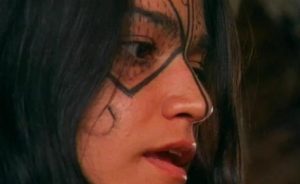 The professional cast had the Portuguese actor Diogo Infante for the homonymous character, Leonardo Villar in the role of the commander, Luciana Riguera as Ánote, and an unrecognizable Floriano Peixoto, who lived the transsexual “Sarita”, in the soap opera “Explode Coração”, as the rude Pedro. Veterans Sérgio Mamberti and Buza Ferraz play secondary roles.
The professional cast had the Portuguese actor Diogo Infante for the homonymous character, Leonardo Villar in the role of the commander, Luciana Riguera as Ánote, and an unrecognizable Floriano Peixoto, who lived the transsexual “Sarita”, in the soap opera “Explode Coração”, as the rude Pedro. Veterans Sérgio Mamberti and Buza Ferraz play secondary roles.
The film’s most discreet focus is on the big clash between the two civilizations. It is an indisputable fact that in the encounter of two different civilizations, the most powerful always subjugates the weakest. This has happened among the Europeans and all the natives, world powers and underdeveloped countries and will occur with Earth when the little green men of Alpha-Centaurus arrive here. What is shown in the movie, and this always occurs, is the phase where the invader is still weak, and the autochthon still has the illusion that it can resist and win.
Another interesting aspect is the positioning of the characters as people, with their desires, aspirations, qualities and defects. Add to this a land at once paradisiacal and infernal, where the survival of each day was a victory and it will be easy to understand the brutal character of all, whites or Indians. Perhaps this is why the title in English was more appropriate: “Brave New Land”, which not only exalts the wild side of the new lands but reminds the original title of the famous work of Aldous Huxley, “Brave new world”.
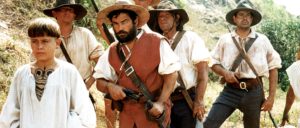 As might be expected, the DVD edition comes with the usual poverty of national productions. The screen format is Full Screen and the audio in Portuguese 2.0 and 5.1. Subtitles are available in French, Spanish and English. The curious thing is that in many scenes when the Indians talk among themselves, there is simply no legend and we do not understand anything! As Extras, there are cast and director notes, movie trailer, production notes, making of, director’s audio commentary, iconography and photo gallery.
As might be expected, the DVD edition comes with the usual poverty of national productions. The screen format is Full Screen and the audio in Portuguese 2.0 and 5.1. Subtitles are available in French, Spanish and English. The curious thing is that in many scenes when the Indians talk among themselves, there is simply no legend and we do not understand anything! As Extras, there are cast and director notes, movie trailer, production notes, making of, director’s audio commentary, iconography and photo gallery.
“Brave New Land” is not by far the richest or best-made production of brazilian cinema. However, in its simplicity it manages to pass on to the spectator another aspect of the social, physical and geographic roots that have resulted in the rich Brazilian culture. Culture that has been dilapidated and “invaded” in the inexorable process of globalization. That’s until the little green men of Alpha-Centaurus arrive. In the meantime, watch the movie, to reconstitute another little piece of the multifaceted mosaic of brazilian history.
